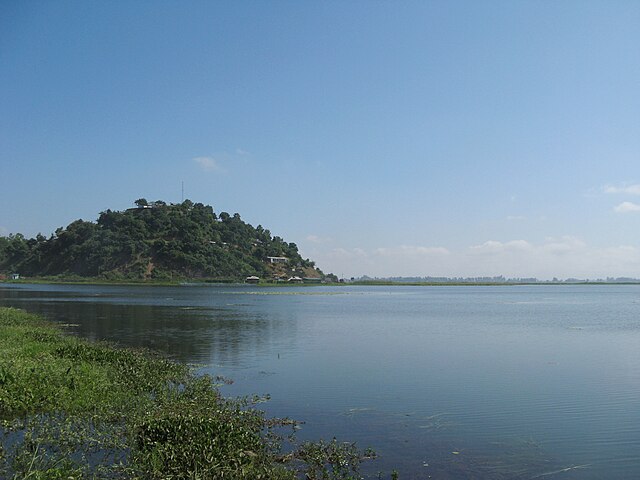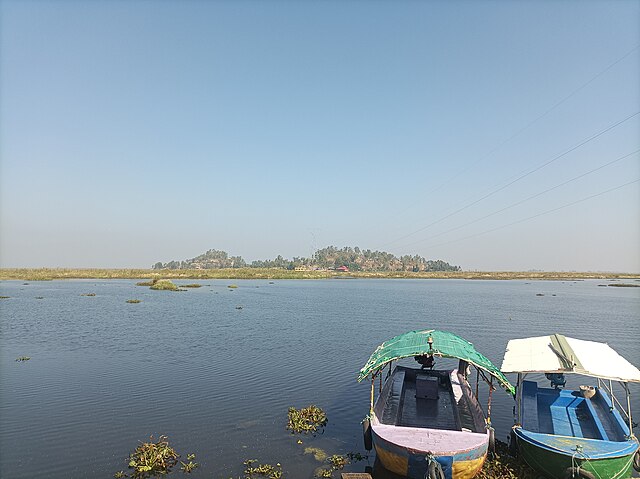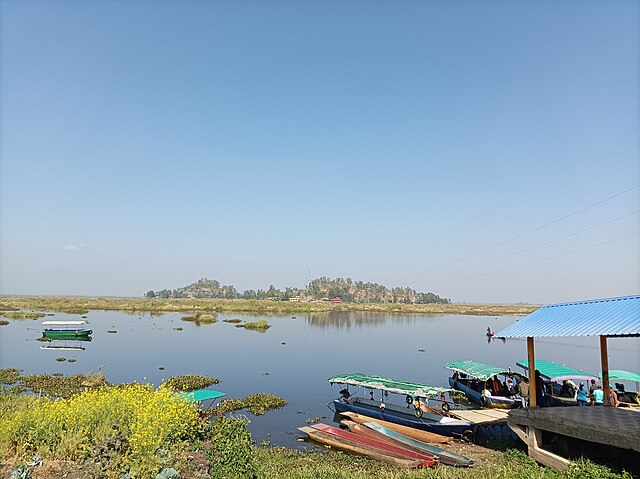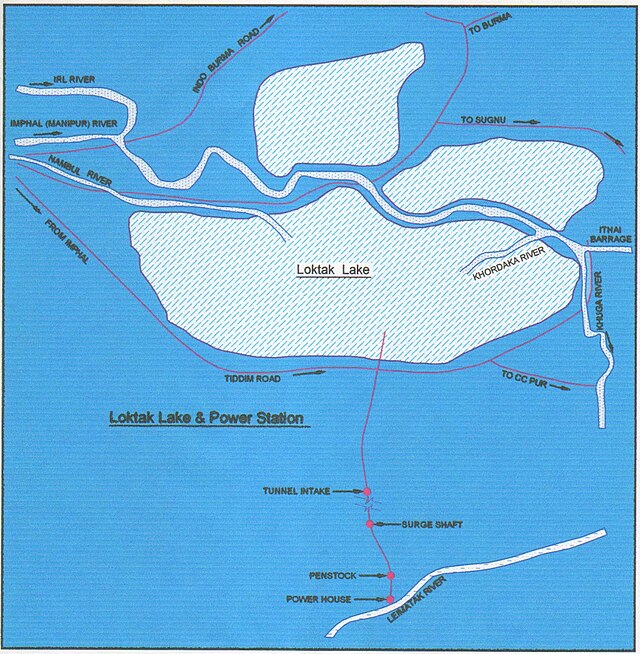Have you ever wondered where you can find a lake that literally floats? Well, let me take you on a journey to one of India’s most extraordinary natural wonders. Loktak Lake, situated in the beautiful state of Manipur, isn’t just any ordinary water body – it’s a living, breathing ecosystem that defies conventional understanding of what a lake should be.
Where Exactly is Loktak Lake Located?

Loktak Lake is situated in the Bishnupur district of Manipur, nestled in the northeastern region of India. This remarkable freshwater lake lies approximately 48 kilometers south of Imphal, the capital city of Manipur. Think of it as nature’s masterpiece, strategically positioned in the heart of the Manipur valley, where it serves as the lifeline for thousands of people.
The lake sits at an elevation of about 768.5 meters above sea level, making it not just geographically significant but also climatically important for the region. Its location in the Indo-Myanmar biodiversity hotspot makes it a treasure trove of unique flora and fauna that you won’t find anywhere else in the world.
Geographic Coordinates and Accessibility
Loktak Lake is positioned at approximately 24°33’N latitude and 93°46’E longitude. These coordinates place it in a sweet spot where the climate remains moderate throughout the year, contributing to its rich biodiversity. The lake’s strategic location makes it easily accessible from major towns in Manipur, serving as a perfect weekend getaway for nature enthusiasts.
Distance from Major Cities
When planning your visit, you’ll find that Loktak Lake is conveniently located from several key destinations. From Imphal, it’s about a 45-minute drive, while from Bishnupur town, it’s merely 7 kilometers away. The nearest railway station is in Dimapur, Nagaland, which is approximately 215 kilometers away, making road travel the most practical option for most visitors.
The Unique Geography of Loktak Lake
What makes Loktak Lake truly special isn’t just where it’s located, but how it’s structured. Imagine a lake that’s alive with floating islands – that’s exactly what you’ll encounter here. These aren’t artificial constructions but natural formations that have evolved over centuries.
Size and Dimensions
Loktak Lake covers an impressive area of approximately 287 square kilometers, making it the largest freshwater lake in Northeast India. During the monsoon season, this area can expand significantly, sometimes reaching up to 500 square kilometers. The lake’s average depth ranges from 2.5 to 4.6 meters, though some areas can be much deeper.
The sheer size of this water body means it plays a crucial role in the region’s water cycle, acting like a giant natural reservoir that helps regulate the local climate and supports countless species of plants and animals.
The Floating Islands Phenomenon
Here’s where things get really interesting. Loktak Lake is famous for its “phumdis” – floating islands made of vegetation, soil, and organic matter. These aren’t small patches of floating grass; some of these phumdis are massive, covering several hectares and supporting entire ecosystems.
What Makes Phumdis So Special?
Think of phumdis as nature’s own houseboats. They’re formed when vegetation decomposes at the bottom of the lake, creating a thick, spongy mass that eventually rises to the surface. Over time, these floating masses become stable enough to support trees, shrubs, and even small huts where local fishermen live and work.
The thickness of these phumdis can vary from a few centimeters to over two meters, and they rise and fall with the water level of the lake. During dry seasons, they might rest on the lake bed, but when water levels rise, they float freely like green carpets on the water’s surface.
Keibul Lamjao: The World’s Only Floating National Park

Located within Loktak Lake is something truly unique – Keibul Lamjao National Park, the world’s only floating national park. This 40-square-kilometer sanctuary is situated on the phumdis and represents one of the most unusual conservation efforts on the planet.
Home to the Endangered Sangai Deer
The primary reason this floating national park exists is to protect the Sangai deer, Manipur’s state animal. These graceful creatures, also known as the brow-antlered deer, are found nowhere else in the world. The Sangai has adapted perfectly to life on the floating phumdis, using their splayed hooves to navigate the spongy surface.
Watching a Sangai deer gracefully move across the floating islands is like witnessing a dance between land and water. These magnificent animals represent the delicate balance of Loktak’s ecosystem and serve as a symbol of Manipur’s natural heritage.
Biodiversity Within the Floating Sanctuary
Beyond the famous Sangai deer, Keibul Lamjao supports an incredible array of wildlife. The park is home to over 100 bird species, including several migratory species that visit during winter months. You might spot the Indian python, wild boar, and various species of cats roaming through this floating wilderness.
The aquatic life is equally impressive, with numerous fish species that form the backbone of the local fishing industry. The unique environment created by the floating phumdis provides breeding grounds and nurseries for many aquatic species.
Cultural and Historical Significance
Loktak Lake isn’t just a natural wonder; it’s deeply woven into the cultural fabric of Manipur. For centuries, local communities have built their lives around this lake, developing unique traditions and practices that reflect their intimate relationship with this floating ecosystem.
Local Communities and Their Lifestyle
The communities living around Loktak Lake have developed a lifestyle that’s perfectly adapted to their environment. Many families live on the phumdis themselves, in traditional huts called “phumsangs.” These floating homes rise and fall with the water levels, creating a lifestyle that’s literally in harmony with nature’s rhythms.
Fishing isn’t just an occupation here; it’s a way of life passed down through generations. The techniques used by local fishermen are unique to this environment, involving special nets and boats designed to navigate the floating islands and varying water depths.
Mythology and Legends Surrounding Loktak
Like many sacred places in India, Loktak Lake is surrounded by fascinating legends and myths. Local folklore speaks of the lake as a gift from the gods, a place where spirits of the water and land come together. These stories aren’t just entertainment; they reflect the deep spiritual connection that local communities have with their environment.
One popular legend tells of how the lake was formed by the tears of a heartbroken princess, which explains why the water is said to have healing properties. Whether you believe in these stories or not, they add a mystical dimension to your visit.
Environmental Challenges and Conservation Efforts

Unfortunately, this natural wonder faces significant challenges. Like many ecosystems around the world, Loktak Lake is under pressure from human activities and environmental changes.
Threats to the Lake’s Ecosystem
The primary threats to Loktak Lake come from multiple sources, and understanding these challenges is crucial for anyone who cares about preserving this unique ecosystem.
Pollution and Human Impact
Agricultural runoff from surrounding areas brings pesticides and fertilizers into the lake, disrupting the natural balance. Urban waste and sewage from nearby settlements add to the pollution load, affecting water quality and aquatic life. The increasing human population around the lake means more pressure on its resources.
Climate Change Effects
Climate change is altering precipitation patterns in the region, affecting the lake’s water levels and the stability of the phumdis. Extreme weather events are becoming more frequent, putting additional stress on this delicate ecosystem.
Government Initiatives and Protection Measures
Recognizing the importance of Loktak Lake, both state and central governments have implemented various conservation measures. The Loktak Lake (Protection) Act of 2006 provides legal framework for conservation efforts, while various restoration projects aim to improve water quality and preserve the unique phumdi ecosystem.
Tourism and Recreational Activities
Despite the challenges, Loktak Lake remains one of Manipur’s top tourist destinations, offering visitors a chance to experience something truly unique.
Best Time to Visit Loktak Lake
The ideal time to visit Loktak Lake is between October and March when the weather is pleasant and wildlife activity is at its peak. During these months, you’ll have the best chance of spotting the Sangai deer and enjoying comfortable boating conditions.
Monsoon season, while beautiful in its own way, can make access difficult and limit outdoor activities. However, if you don’t mind the rain, the lake during monsoons offers a completely different perspective with lush green phumdis and dramatic skies.
Popular Tourist Attractions Around the Lake
Sendra Island
Sendra Island, one of the larger phumdis, has been developed as a tourist destination with a resort and various recreational facilities. From here, you can enjoy panoramic views of the lake and observe the floating islands from a comfortable vantage point.
Boat Rides and Water Sports
Boat rides are the primary way to explore Loktak Lake, offering close-up views of the phumdis and wildlife. Local operators provide guided tours that include visits to fishing villages and the floating national park. Some areas also offer kayaking and other water sports for the more adventurous visitors.
How to Reach Loktak Lake
Getting to Loktak Lake requires some planning, but the journey is part of the adventure.
By Air
The nearest airport is Imphal International Airport, located about 53 kilometers from the lake. Regular flights connect Imphal with major Indian cities like Delhi, Kolkata, and Guwahati. From the airport, you can hire a taxi or take a bus to reach the lake.
By Road
Road connectivity to Loktak Lake is good, with well-maintained highways connecting it to major towns in Manipur and neighboring states. The journey from Imphal takes about an hour by car, passing through scenic countryside and traditional villages.
Local Transportation Options
Local buses and shared taxis are available from Imphal and other major towns. For more flexibility, hiring a private vehicle is recommended, especially if you plan to explore multiple spots around the lake.
Accommodation and Facilities

While accommodation options around Loktak Lake are limited compared to major tourist destinations, there are several choices ranging from government guesthouses to private resorts. The Sendra Tourist Home on Sendra Island offers a unique experience of staying on a floating island, while Imphal provides more comprehensive accommodation options with easy access to the lake.
Basic facilities like restaurants and boat rental services are available at key tourist spots around the lake. However, it’s advisable to carry essentials and be prepared for a more rustic experience compared to urban destinations.
Economic Importance to Manipur
Loktak Lake isn’t just an ecological treasure; it’s also economically vital for the state of Manipur.
Fishing Industry
The lake supports the livelihoods of thousands of fishermen and their families. The unique ecosystem provides ideal conditions for various fish species, making it a significant contributor to Manipur’s fish production. The traditional fishing methods practiced here are sustainable and have been refined over generations.
Hydroelectric Power Generation
The Ithai Barrage, constructed at the southern end of the lake, is part of the Loktak Multipurpose Project that generates hydroelectric power for the region. This project provides electricity to much of Manipur, making the lake crucial for the state’s energy security.
Future Prospects and Sustainable Development
The future of Loktak Lake depends on balancing development needs with conservation requirements. Sustainable tourism initiatives are being developed to provide economic benefits while minimizing environmental impact. Community-based conservation programs are showing promising results, involving local people in protecting their natural heritage.
Research and monitoring programs are providing valuable data on the lake’s ecosystem, helping scientists and policymakers make informed decisions about its management. International collaboration and funding are supporting these efforts, recognizing Loktak Lake as a global treasure that needs protection.
Conclusion
Loktak Lake, situated in the heart of Manipur, represents one of nature’s most remarkable creations. This floating ecosystem, with its unique phumdis and diverse wildlife, offers visitors an experience unlike anywhere else in the world. From the endangered Sangai deer to the fishing communities who call this place home, every aspect of Loktak Lake tells a story of adaptation, resilience, and natural beauty.
While the lake faces environmental challenges, ongoing conservation efforts and growing awareness offer hope for its future. Whether you’re a nature enthusiast, a cultural explorer, or simply someone seeking a unique travel experience, Loktak Lake provides an unforgettable journey into one of India’s most extraordinary natural wonders.
The question “Where is Loktak Lake situated?” opens the door to discovering not just a geographical location, but a entire world where water meets land in the most beautiful and unexpected ways. Plan your visit to this floating paradise and become part of the story of conservation and wonder that continues to unfold at Loktak Lake.
Frequently Asked Questions (FAQs)
1. What makes Loktak Lake unique compared to other lakes in India? Loktak Lake is unique because of its floating islands called phumdis, which are made of vegetation and organic matter. It’s also home to the world’s only floating national park and the endangered Sangai deer found nowhere else on Earth.
2. Is it safe to visit Loktak Lake throughout the year? Yes, Loktak Lake is generally safe to visit year-round, but the best time is between October and March when weather conditions are most favorable. During monsoons, some activities might be limited due to heavy rainfall.
3. Can tourists stay overnight on the floating islands? Yes, there are accommodation options available on Sendra Island, one of the larger phumdis. The Sendra Tourist Home offers a unique experience of staying on a floating island, though facilities are basic.
4. How long does it take to explore Loktak Lake properly? A full day is sufficient to cover the main attractions of Loktak Lake, including boat rides and wildlife viewing. However, staying 2-3 days allows for a more comprehensive exploration and better chances of wildlife sightings.
5. What permits are required to visit Keibul Lamjao National Park? Visitors need to obtain entry permits for Keibul Lamjao National Park, which can be arranged through local tour operators or at the park entrance. It’s advisable to check current regulations and fees before planning your visit.

